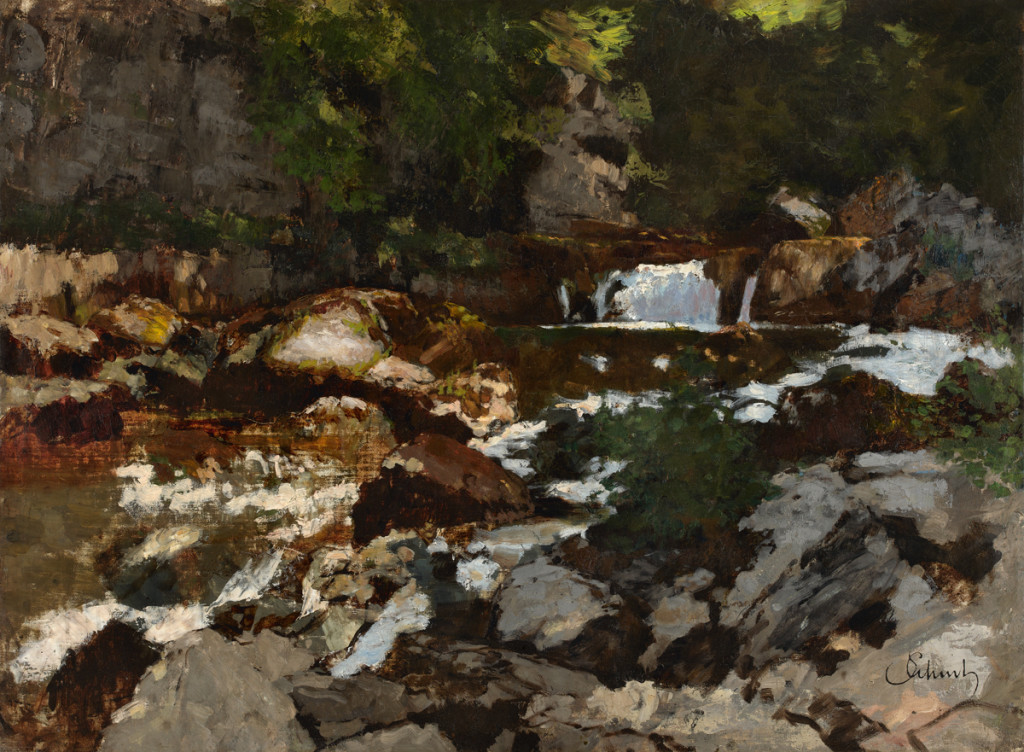Carl Schuch (1846 - Vienna - 1903)
Mountain Stream with Waterfall, Saut du Doubs, c. 1890
Oil on canvas, 60.3 x 81.8 cm
Signed lower right in facsimile CSchuch
Labels affixed to the stretcher on the reverse include one inscribed Ch. Schuch No 332 / Wildbach bei Saut de Doubs
Provenance:
Schuch estate; sold 4 January 1911
Karl Haberstock, Berlin; sold 4 October 1912
Eugen Deter, Berlin
Hugo Helbing, Munich, 16 October 1928, lot 86
Hugo Helbing, Munich, 10 March 1932, lot 145
Hugo Helbing, Munich, 21 December 1932, lot 115
Friedrich Kaltreuther, Mannheim
Carl Wambsganss, Mannheim; acquired 1935, placed on permanent loan to the Städtische Kunsthalle, Mannheim (inv. no. S 9)
Wambsganss estate
Private collection, Germany
Literature:
Karl Hagemeister, Karl Schuch. Sein Leben und seine Werke, Berlin 1913, ill. p.164
Arnold Gehlen, Zeit-Bilder, Frankfurt am Main 1960, p.57
Rudolf Migacz, Carl Schuch als Landschaftsmaler, Ph.D. thesis, University of Vienna, 1973, p.78 and no. 116
Exhibited:
On permanent loan to the Städtische Kunsthalle, Mannheim (inv. no. S 9), until 2008
Carl Schuch 1846-1903, Städtische Kunsthalle, Mannheim, 8 March - 19 May 1986, and Städtische Galerie im Lenbachhaus, Munich, 11 June - 11 August 1986, cat. no. 123, pp.332-33
Carl Schuch: Ein europäischer Maler, Österreichische Galerie Belvedere, Vienna, 26 June - 14 October 2012, cat. p.136
From 1886 to 1893 Carl Schuch spent his summers in the French Jura, staying near the Saut du Doubs, a notable waterfall on the river Doubs, not far from the town of La Chaux-de-Fonds. The countryside through which the river flows at this point near the Swiss border is an area of outstanding natural beauty, famed for its lakes, woods and waterfalls. Schuch most probably painted Mountain Stream with Waterfall, Saut du Doubs in the summer of 1890. Like the roughly contemporary oil sketch Doub Valley, c. 18901, he executed it sur le motif. Both works doubtless depict the same waterfall from different angles.
The art historian Arnold Gehlen, writing in 1960, asserted that the landscapes Schuch produced on his visits to the Jura could stand comparison with those of Paul Cézanne.2 This view was echoed in the catalogue and contents of the exhibition Cézanne, Manet, Schuch: Drei Wege zur autonomen Kunst, mounted in Dortmund in 2000.3 A wider public has become acquainted with Schuch's oeuvre only gradually, over the past thirty years, despite the fact that many important public collections in Austria and Germany have long possessed examples of his art.4 This increased awareness can be attributed to the catalogue of the artist's work compiled by Claus Korte and currently being updated by Roland Dorn, to an extensive retrospective staged in Mannheim and Munich in 1986 and to a major Schuch exhibition at the Belvedere, Vienna, in 2012. The Dortmund exhibition of 2000 emphasised the artist's importance in the development of European painting as a whole, while the catalogue of the show in Vienna offered significant new insights into his artistic ideas and works by publishing the contents of his notebooks for the first time.5
The three exhibitions did much to resolve the marked discrepancy between general neglect of Schuch's work and its remarkable impact on painters in Germany and abroad during the second half of the nineteenth century. They did not, however, redress the balance entirely.
Schuch's paintings were unknown to the art world at large during his lifetime. He contributed to only one exhibition and sold only one picture. Plagued by what he saw as his artistic inadequacy, he denied himself further opportunities to exhibit. Since he was financially independent, he could pursue his career untroubled by the need to sell his work. Familiarity with his art was thus restricted to his fellow painters, who collected it avidly.
After training in Vienna, Schuch travelled from city to city and country to country. He was based first in Munich, where he came under the influence of Wilhelm Trübner and the artists surrounding Wilhelm Leibl, and then in Venice, before moving to Paris in 1882. In 1894 he left the French capital for Vienna, where he spent the last decade of his life in ill health and eventually died in a mental asylum in 1903.
During his Paris years, Schuch, like other artists from the German-speaking world, engaged closely with the work of French avant-garde painters. Yet, unlike his compatriots, he did so as an equal, not as a student. His sensitive, individual response to the work of Cézanne, Gustave Courbet and Edouard Manet set him apart from many of his contemporaries, who adopted a more imitative approach.
Today, Schuch's still lifes are as highly regarded as his landscapes. He would not have found this flattering, for he sought to overturn the hierarchy of genres propagated by academic artists and complied with by the majority of his contemporaries. In his scheme of things, history painting rated lowest and was followed in order of increasing value by still life, architectural painting, landscape studies and landscape painting.6 Skill in architectural painting and still life he regarded merely as stages in an artist's development: the peak of artistic achievement consisted in the ability to paint an ‘ideal landscape'.
1. Bayerische Staatsgemäldesammlungen, Munich; Agnes Husslein-Arco and Stephan Koja (eds.), Carl Schuch: Ein europäischer Maler, exhib. cat., Österreichische Galerie Belvedere, Vienna 2012, ill. p.134.
2. Arnold Gehlen, Zeit-Bilder, Bonn 1965², p.57: ‘With their stylistic brilliance, the Doubs landscapes that Carl Schuch executed shortly before his breakdown around 1890 are no mean achievement and can be ranked alongside Cézanne in terms of originality, handling of space and chromatic effect.'
3. Brigitte Buberl (ed.), Cézanne, Manet, Schuch: Drei Wege zur autonomen Kunst, exhib. cat., Dortmund, Museum für Kunst und Kulturgeschichte, 30 May to 30 July 2000, Munich 2000.
4. The Alte Nationalgalerie, Berlin, however, acquired Schuch's A Dead Fox, from Daxer & Marschall, as recently as 2013.
5. Roland Dorn, in Husslein-Arco and Koja, op. cit.
6. Carl Schuch. 1846-1903, Mannheim, Städtische Kunsthalle, and Munich, Städtische Galerie im Lenbachhaus, Freiburg im Breisgau 1986, p.20.

